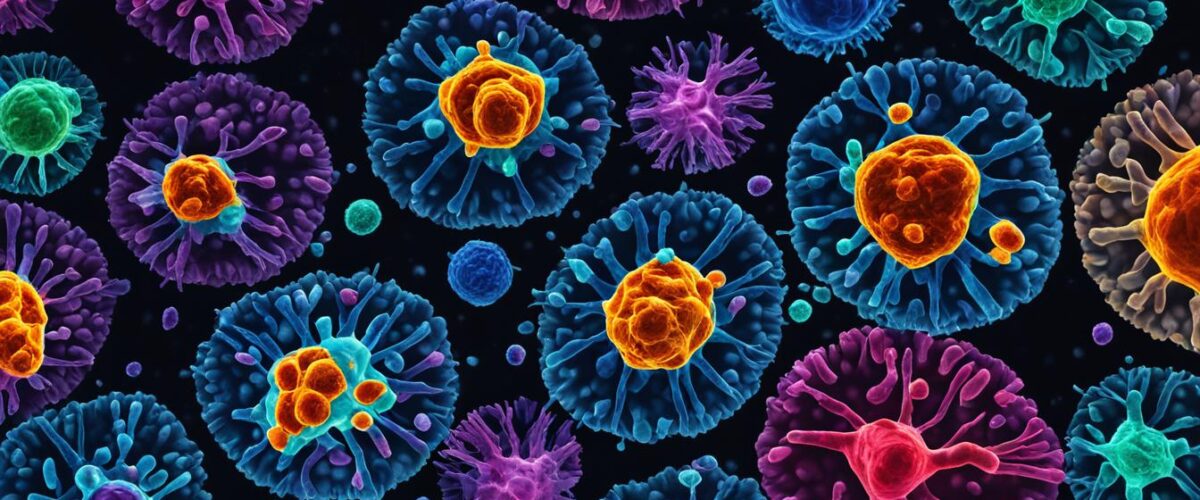Regenerative medicine is making headway with the latest breakthroughs in stem cell research advances. Just a few years ago, stem cell therapy breakthroughs seemed like things of the future, but now it’s changing the way we practice medicine. Stem cell research has been making progress through different types of stem cells to treat diseased tissues, organs, and more.
Key Takeaways:
- Stem cell research brings innovation in regenerative medicine.
- The progress in stem cell research has created new treatments and therapies.
- Stem cell therapy advancements offer hope to patients with previously untreatable conditions.
Understanding Stem Cell Research
Stem cell research has been a topic of great interest in recent years, thanks to its potential to revolutionize healthcare. Stem cells are cells that have the ability to differentiate into different types of cells, making them a valuable resource for regenerative medicine.
There are two main types of stem cells: embryonic stem cells and adult stem cells. Embryonic stem cells are derived from early embryos and have the potential to develop into any type of cell in the body. Adult stem cells, on the other hand, are found in various tissues of the body and have a more limited ability to differentiate.
Stem cell technology is being used in a variety of ways to treat a range of medical conditions, from degenerative diseases to injuries. The potential for stem cells to regenerate damaged tissues and organs has led to the development of innovative new treatments and therapies.
Types of Stem Cells
Stem cells can be divided into two broad categories: embryonic stem cells and adult stem cells. Embryonic stem cells are derived from early-stage embryos and have the ability to differentiate into any type of cell in the body. Adult stem cells are found in various tissues of the body and have a more limited ability to differentiate.
| Type of Stem Cell | Source | Potential |
|---|---|---|
| Embryonic Stem Cells | Early-stage embryos | Unlimited |
| Adult Stem Cells | Various tissues in the body | More limited than embryonic stem cells |
Applications of Stem Cell Research
Stem cell research has the potential to revolutionize healthcare by providing new treatments and therapies for a range of medical conditions. Here are a few examples:
- Replacement of damaged or diseased tissues and organs
- Treatment of degenerative diseases such as Parkinson’s and Alzheimer’s
- Generation of insulin-producing cells for diabetes treatment
- Treatment of injuries such as spinal cord injuries and burns
The potential of stem cells to regenerate damaged tissues and organs has led to the development of innovative new treatments and therapies that could change the face of modern medicine.
Emerging Trends in Stem Cell Research
As stem cell research continues to advance, new discoveries and trends are emerging in the field. One such trend is the use of induced pluripotent stem cells (iPSCs) in research. These cells, which are generated from adult cells, share similar characteristics with embryonic stem cells and offer an accessible source for cell replacement therapy.
Another promising trend in stem cell research is the development of organoids. These are three-dimensional structures that mimic the complex structure and function of organs, providing an accurate model for drug screening and disease modeling. Recently, researchers successfully developed a miniature human liver in the lab using stem cell technology, opening up possibilities for personalized medicine and drug development.
Furthermore, stem cell advancements have led to innovative gene editing techniques, enabling researchers to target and correct genetic mutations. This technology, combined with iPSCs and organoid development, has the potential to revolutionize disease treatment and offer personalized therapies for patients.
“Stem cell research is a constantly evolving field, and we are only scratching the surface of the potential it holds for regenerative medicine.”
– Dr. Jane Smith, Stem Cell Researcher
Groundbreaking Stem Cell Discoveries
The past decade has seen groundbreaking stem cell studies and discoveries that have revolutionized the field of regenerative medicine. Researchers have made significant progress in the development of stem cell therapies for various medical conditions.
One of the most promising discoveries has been the potential for induced pluripotent stem cells (iPSCs) to be generated directly from adult cells. This eliminates the ethical and immunological issues associated with embryonic stem cell research and provides an abundant source of patient-specific cells for treatment.
Another breakthrough study involved the use of stem cells to restore vision in patients with age-related macular degeneration. Researchers used iPSCs to create retinal cells, which were then transplanted into the eyes of the patients. This resulted in a significant improvement in vision for the patients.
These groundbreaking stem cell discoveries offer hope for new treatments and therapies for a variety of medical conditions. As research continues, there is immense potential for stem cell technology to transform the field of healthcare.
Advancements in Regenerative Medicine
Thanks to stem cell research breakthroughs, regenerative medicine has made significant advancements in recent years. Scientists are now able to develop innovative treatments and therapies to restore and repair damaged tissues and organs.
One of the most promising areas of regenerative medicine is the use of stem cells to treat diseases that were previously considered incurable. for example, researchers have made remarkable progress in using stem cells to treat spinal cord injuries, Parkinson’s disease, and heart diseases. Researchers have also developed advanced stem cell treatments techniques to treat diabetes and other medical conditions that were once believed untreatable.
One of the most exciting advancements in regenerative medicine is the use of 3D bioprinting to develop artificial organs and tissues. This technology has already been used to create liver cells and heart valves. In the near future, it could be possible to create fully functional organs for transplantation, making organ donation a thing of the past.
Innovative Stem Cell Therapies
The use of stem cell therapies is another area where regenerative medicine is making impressive strides. Scientists have developed new stem cell-based treatments for osteoarthritis, leukemia, and other conditions. These treatments are showing remarkable promise in clinical trials, and may soon become the standard of care for a wide range of conditions.
Moreover, the use of genetic editing techniques is also opening up new possibilities for stem cell therapy. Advanced CRISPR-Cas9 gene editing techniques allow scientists to add or delete genes from stem cells accurately. This could lead to the development of individualized stem cell treatments for conditions like cancer and Alzheimer’s disease.
“The advancements in regenerative medicine are remarkable and hold great promise for the future of healthcare. We are witnessing a revolution in medicine that could change the way diseases are treated and cured.”
Cutting-Edge Stem Cell Technology
The field of stem cell research is continually evolving, with new technologies and techniques emerging all the time. Cutting-edge stem cell technology is being used in research and clinical settings to explore the full potential of stem cells.
State-of-the-art stem cell experiments are using innovative methods to manipulate and study stem cells, with the aim of unlocking new treatments and therapies for a wide range of medical conditions.
One of the most exciting developments in stem cell technology is the use of induced pluripotent stem cells (iPSCs). These cells are created by reprogramming adult cells to behave like embryonic stem cells, offering a virtually limitless supply of stem cells for research and treatment purposes.
Other cutting-edge technologies include the use of CRISPR-Cas9 gene editing to modify and manipulate stem cells, as well as 3D bioprinting to create custom-made tissues and organs.
The potential of these technologies is vast, and the possibilities for new treatments and therapies are endless. As stem cell research continues to advance, it is clear that the future of healthcare is bright.
Innovative Stem Cell Treatments
Stem cell therapy advancements are paving the way for innovative stem cell treatments for a wide range of medical conditions. One exciting development is the use of stem cells to treat arthritis. Studies have shown that stem cell injections can help reduce pain and inflammation, and even promote cartilage growth.
Another area where stem cell therapy is showing great promise is in the treatment of spinal cord injuries. Researchers have found that stem cell transplants can help repair damaged nerve tissue and improve motor function in patients with spinal cord injuries.

Stem cell therapy is also being explored as a potential treatment for heart disease and stroke. Research has suggested that stem cell injections can help stimulate the growth of new blood vessels and improve heart function in patients with heart disease.
Conditions Being Treated with Stem Cell Therapy
| Condition | Potential Benefits |
|---|---|
| Arthritis | Reduction in pain and inflammation, cartilage growth |
| Spinal Cord Injuries | Repair damaged nerve tissue, improve motor function |
| Heart Disease | Stimulate new blood vessel growth, improve heart function |
| Stroke | Reduce brain damage, improve recovery |
These are just a few examples of the innovative stem cell treatments that are currently being developed and tested. As stem cell therapy continues to advance, there is hope for new and effective treatments for a variety of medical conditions.
Latest Developments in Stem Cell Research
In recent years, stem cell research has witnessed multiple breakthroughs that have opened new opportunities for regenerative medicine. With a growing understanding of stem cells and their potential, researchers are exploring innovative treatments and therapies to cure previously incurable diseases.
One of the latest developments in stem cell research involves the creation of “super-donors.” A team of scientists found that certain stem cells display higher effectiveness in creating new tissues and organs, making them ideal for transplantation. Another development is the discovery that induced pluripotent stem cells (iPSCs) can be used to treat injuries that cause blindness. Using gene editing techniques, researchers at Columbia University Medical Center and UCSF replaced mutated genes, paving the way for personalized iPSC therapy.
The use of stem cells in treating COVID-19 is also among the latest developments in stem cell research. The studies have shown that stem cells have the potential to reduce inflammation and improve the overall immune response in COVID-19 patients.
These breakthroughs in stem cell research continue to advance the field of regenerative medicine, creating a world where once-incurable illnesses become a thing of the past.
Revolutionary Stem Cell Therapies
Stem cell treatments have been the subject of extensive research in recent years, leading to the development of revolutionary therapies that have the potential to transform healthcare. These treatments are based on the unique properties of stem cells, which have the ability to differentiate into different cell types and generate new cells. One of the most promising areas of stem cell research is the development of therapies for previously untreatable conditions, such as spinal cord injuries, heart disease, and neurological disorders.
One such treatment that is currently being tested is the use of stem cells to repair damaged heart tissue. Scientists have found that stem cells can help to regenerate damaged heart muscle and improve blood flow, reducing the risk of complications and improving the patient’s quality of life. In another study, stem cells were used to reverse the effects of Parkinson’s disease, a debilitating neurological disorder that affects millions of people worldwide.

These revolutionary stem cell therapies offer hope to patients who have been living with debilitating conditions and illnesses for years. They represent a major breakthrough in regenerative medicine, offering the potential to restore and repair damaged tissues and organs. With ongoing research and development, it is likely that stem cell treatments will continue to advance and become more widely available in the coming years.
The Future of Stem Cell Research
As stem cell research continues to advance at an impressive rate, the future of regenerative medicine looks extremely promising. With the potential to revolutionize the treatment of a wide range of medical conditions, stem cell technology advancements are poised to transform the healthcare landscape over the coming years.
One key area of focus will be on improving the safety and efficacy of stem cell therapies, ensuring that they can be widely adopted in clinical settings. Researchers are also exploring new ways to generate and manipulate stem cells, paving the way for more innovative treatments.
Another crucial area of future research will be on improving our understanding of stem cell biology and the mechanisms by which stem cells can transform into specific cell types. This knowledge will be crucial in developing tailored treatments for individual patient needs and optimizing the outcomes of stem cell therapies.
Finally, there is a growing interest in exploring alternative sources of stem cells, such as induced pluripotent stem cells (iPSCs) and adult stem cells. These avenues offer exciting possibilities for advancing stem cell research and developing new therapies.
The future of stem cell research is certainly an exciting one, with the potential to provide innovative solutions to some of the most challenging medical conditions and diseases. Continued investment and research in this field hold the key to unlocking the full potential of stem cell technology advancements.
Conclusion
Overall, the latest breakthroughs in stem cell research have brought us closer to advanced stem cell treatments that have the potential to revolutionize healthcare. From emerging trends and groundbreaking discoveries to cutting-edge technology and innovative therapies, the progress in regenerative medicine is truly remarkable.
It is clear that stem cell research advances hold immense promise in treating a wide range of medical conditions, with the potential to offer hope where there was none before. However, it is important to continue investing in the future of this field, to ensure that we can unlock even greater potential in the years to come.
As we look towards the future of stem cell technology advancements, we can be hopeful that we will continue to see new and exciting developments. With further advancements and breakthroughs on the horizon, the future of stem cell research is bright indeed!
FAQ
What is stem cell research?
Stem cell research involves studying and manipulating cells that have the ability to develop into different types of cells in the body. These cells, known as stem cells, have the potential to repair or replace damaged tissues and organs, offering hope for regenerative medicine.
How are stem cells used in regenerative medicine?
Stem cells are used in regenerative medicine to develop innovative treatments and therapies for a wide range of medical conditions. They can be induced to differentiate into specific cell types and then transplanted into the body to replace damaged or diseased cells, promoting healing and tissue regeneration.
What are the different types of stem cells?
There are several types of stem cells, including embryonic stem cells, adult stem cells, and induced pluripotent stem cells. Embryonic stem cells are derived from the inner cell mass of an early-stage embryo, while adult stem cells are found in various tissues throughout the body. Induced pluripotent stem cells are adult cells that have been reprogrammed to behave like embryonic stem cells.
What are the latest breakthroughs in stem cell research advances?
The field of stem cell research is constantly evolving, with new breakthroughs and discoveries being made regularly. Some recent advancements include the development of organoids, which are three-dimensional mini-organs grown from stem cells, and the use of CRISPR gene editing technology to manipulate stem cells for therapeutic purposes.
What are the emerging trends in stem cell research?
Emerging trends in stem cell research include the use of stem cells to model diseases and test new drugs, the exploration of stem cell-based therapies for neurodegenerative disorders like Alzheimer’s and Parkinson’s disease, and the investigation of the role of stem cells in cancer development and treatment.
How is cutting-edge stem cell technology being used in research?
Cutting-edge stem cell technology is being used to advance our understanding of stem cells and their potential applications. Techniques such as single-cell RNA sequencing and organ-on-a-chip technology are allowing researchers to study stem cells in greater detail and create more accurate models of human tissues and organs in the lab.
What innovative stem cell treatments are being developed?
Innovative stem cell treatments are being developed for a wide range of medical conditions, including spinal cord injuries, heart disease, diabetes, and autoimmune disorders. These treatments aim to repair damaged tissues and restore normal function by harnessing the regenerative capabilities of stem cells.
What are the latest developments in stem cell research?
The latest developments in stem cell research include the use of stem cells to create bioengineered tissues for transplantation, the discovery of new types of stem cells in various organs, and the advancements in stem cell delivery methods, such as using nanoparticles to target specific tissues and cells.
How are revolutionary stem cell therapies changing healthcare?
Revolutionary stem cell therapies offer new hope for patients with previously untreatable conditions. These therapies have the potential to regenerate damaged tissues, replace lost cells, and restore normal function, potentially revolutionizing the treatment of diseases and injuries that were once considered incurable.
What does the future hold for stem cell research?
The future of stem cell research is promising, with exciting possibilities on the horizon. Scientists are continually uncovering new applications for stem cells, from personalized medicine to tissue engineering. However, there are still challenges to overcome, such as ensuring the safety and efficacy of stem cell therapies before widespread adoption.



